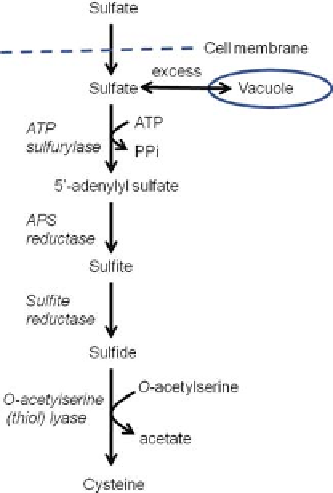Environmental Engineering Reference
In-Depth Information
Fig. 3.1
Flow diagram of sulfate reduction pathway in phytoplankton. Adapted from [54]
3.4 Metallothioneins
Metallothioneins are peptides and relatively small proteins containing cysteine
residues that bind to metals such as zinc, copper and cadmium. They may also be
intimately involved in metal sulfide production [55, 56].
When eukaryotic algal species are exposed to heavy metals, an induced stress
response is activated causing the synthesis of class II metallothioneins (MtII) (iden-
tified in cyanobacteria, algae and higher plants) and class III metallothioneins
(MtIII) (found in most algal species, higher plants and fungi). The latter are also
known as phytochelatins [57]. The classes of these metal binders differ in their
positions and numbers of cysteines. Class I, the archetypal mammalian protein
group, and class II are encoded by their respective genes whereas class III, the
phytochelatins, are enzymatically synthesized.
3.4.1 Class II Metallothioneins
The processes governing how and when class II metallothioneins are employed
by organisms are not entirely clear. Their regulation may be linked to the age of
the organism, enzyme sensitivities to specific heavy metals, and the essential or
non-essential nature of the heavy metals, themselves [58]. Interestingly, MtII tends
to preferentially bind with zinc ions, and thus the types of metallothioneins appear
to have metal specificity [59].

